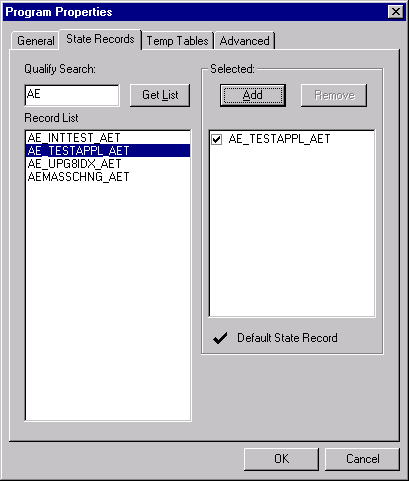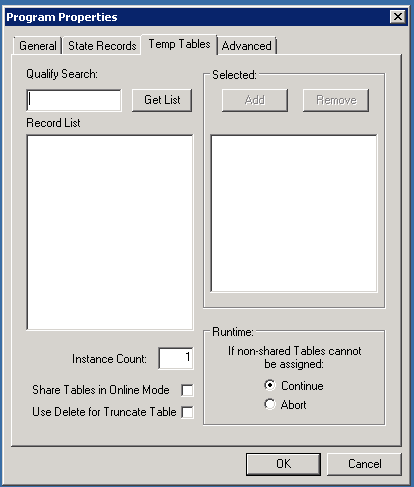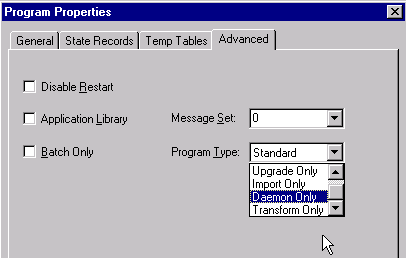Setting Program Properties
This section discusses how to:
Access properties.
Set general properties.
Set state record properties.
Specify temporary tables.
Set advanced properties.
When you have an Application Engine program open in Application Designer, you can view and modify the properties assigned to an entire program just as you would a step or a section.
To view or modify the properties associated with a program, click the Properties button or select File, Definition Properties while the program is open. You can also press Alt+Enter. The Program Properties dialog box appears.
Access the Program Properties dialog box and select the General tab. You can specify identification values for your Application Engine program.
|
Field or Control |
Definition |
|---|---|
| Owner ID |
(Optional) Enter the owner ID for the program. The owner ID is a way to identify which definitions are owned by which PeopleSoft applications, such as PeopleSoft General Ledger, Accounts Receivables, and so on. The values in the drop-down list are Translate table values associated with the OBJECTOWNERID field. |
Select the State Records tab.
Image: Program Properties dialog box: State Records tab
This example illustrates the fields and controls on the Program Properties dialog box: State Records tab. You can find definitions for the fields and controls later on this page.

|
Field or Control |
Definition |
|---|---|
| Qualify Search |
Enter any wildcard characters or complete table names to limit the results that appear in the record list. By default, the Record List text box contains all record names that end with the extension AET. This extension identifies the record as an Application Engine record. |
| Get List |
Click to populate the Record List text box. |
| Record List |
This text box contains the results of your state record search. |
| Selected |
Select state records for use with a particular program. Click Add to include selected records from the record list into the selected list. ClickRemove to remove selected records from the selected list. Indicate which state record will act as the default state record by selecting its check box. For your default state record, you need to reference only field names in your PeopleCode and SQL (for the active program). When you reference a non-default state record, you do so by using recname.fieldname. |
Select the Temp Tables tab.
Image: Program Properties dialog box: Temp Tables tab
This example illustrates the fields and controls on the Program Properties dialog box: Temp Tables tab. You can find definitions for the fields and controls later on this page.

Temporary tables store intermediate results during a program run.
Note: You must have defined required temporary tables in your database before you can associate them with an Application Engine program.
|
Field or Control |
Definition |
|---|---|
| Qualify Search |
Enter any wildcard characters or complete table names to limit the results that appear in the record list. By default, the Record List text box contains only records that are of type Temporary Table. You apply this attribute when you create the record in Application Designer. |
| Get List |
Click to populate the Record List text box. |
| Record List |
This text box contains the results of your search for temporary tables. |
| Selected |
Select temporary tables for use with a particular program. Click Add to include selected records that appear in the record list. ClickRemove to exclude selected records that appear in the selected list. |
| Instance Count |
Enter the number of physical tables to be created for each dedicated table for this program during the SQL Build procedure in Application Designer. Typically, you would set this number to equal the maximum number of parallel program runs that you anticipate. For instance, if you expect up to five instances of the same program to run simultaneously, then you would set the instance count to 5. |
| Share Tables in Online Mode |
Select to enable online temporary table sharing. By default, this check box is not selected. If the temporary tables need to be shared for this particular Application Engine program when run in online mode, this has to be selected. When an online Application Engine instance cannot allocate itself a dedicated temporary table, this instance will share a temporary table already used by another instance(s), improving the online performance. |
| Use Delete for Truncate Table |
Select to delete the temporary table during allocation of the Application Engine process. By default, this check box is not selected. Use Delete for Truncate table improves the performance of Application Engine process. |
| Insert Selected list into Project |
If the active Application Engine program definition belongs to a project, select this check box to include the dedicated temporary tables for this program within the same project. |
| Runtime |
Control how an Application Engine program acts if an instance of its specified dedicated temporary tables is not available. If you select Continue, then Application Engine uses the base version, or undedicated version, of the temporary tables. If you selectAbort, then the program exits with an error message. |
Note: If the table is keyed by PROCESS_INSTANCE and the application SQL includes the process instance in the Where clause, then multiple processes can share the table. The best performance, however, occurs when a program runs against a dedicated temporary table instance.
Select the Advanced tab.
Image: Program Properties dialog box: Advanced tab
This example illustrates the fields and controls on the Program Properties dialog box: Advanced tab. You can find definitions for the fields and controls later on this page.

|
Field or Control |
Definition |
|---|---|
| Disable Restart |
Select to disable the built-in restart capabilities for a particular program. |
| Application Library |
In some cases, you may want a program to contain only a collection, or library, of common routines (in the form of callable sections) that you do not want to run as a standalone program. When sections are defined as public, other programs can call the sections, or routines, that exist in the library at runtime. Because this type of program is not designed to run as a standalone program, it does not require the MAIN section, or initial entry point. Select this check box to rename or remove any existing MAIN section. Note: An application library is the appropriate location to store a collection of shared Application Engine program sections. Libraries are not intended for storing a specific SQL action within a section. To share common SQL, use the SQL repository. |
| Batch Only |
Select for batch-only programs. Batch-only programs are not run from the CallAppEngine PeopleCode function. Any dedicated temporary table used for batch-only programs does not have online instances created. |
| Message Set |
Specify the default message set value for this program. The system uses this message set value for all Log Message actions for which the message set is not specified. |
| Program Type |
Select from:
|